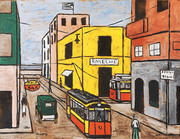
“The Modern and the Mythic: Francisco Matto” shows one of Joaquín Torres-Garcia’s most commercially successful students to also be one of the most resonant, though curator Gabriel Perez-Barreiro goes out of his way to disprove the existence of a causal relationship between the former and the latter. Matto’s economical use of forms and strokes, which remained constant from the 1940s to the ’90s, refreshingly obfuscates any narrative of stylistic development. To illustrate the cohesiveness of Matto’s oeuvre, the show wends through several clusters of galleries—some exhibiting vertical two-dimensional paintings, others with long platforms installed to support Matto’s rough, totemic, uncannily human-scale wooden sculptures. The result is a topography in step with the spiritual utopia that many of his works evoke.
The notion of provincialism is also challenged; photographs of Matto working in his native Montevideo are installed around the corner from the artist’s electrifying paintings of the city. Oils on cardboard—and perfectly preserved ones at that—like Geniol, 1956, and Perspectivo, 1957, turn sleepy port landscapes into proto-hard-edge abstraction. The pitch-perfect treasures of this show, however, are Matto’s pen-and-ink and watercolor works: succinct pieces, most smaller than a sheet of notebook paper, that reveal the more everyday tics of Matto’s practice. His painted grids, crammed with primary-colored lines and pictograms, will be familiar to devotees of Torres-Garcia’s workshop milieu, but the collection of lesser-known objects forms a gentle, insistent bas-relief whole that rings quietly long after the viewer absorbs their context.
Просмотреть увеличенную карту |

That the work of Shepard Fairey suddenly finds itself in a storm of publicity––from GQ to the New York Times––seems not only preordained but a bit tautological. For Fairey’s work began as a germ of ubiquitous, “viral” publicity, in the legendary form of small stickers depicting the mug of Andre the Giant, a former pro-wrestling phenomenon. ANDRE THE GIANT HAS A POSSE, announced these enigmatic decals, plastered in the most unlikely of places by a seemingly anonymous army in the early 1990s. (When someone offered one to me fifteen years ago, I duly placed it on my notebook. There was a strange thrill––mixed with misgiving––at being part of a nameless posse headed by a melancholic giant.) But suspicions that this phenomenon entailed more Big Brother than brotherly love have been dispelled. Fairey’s anonymity has crystallized into a multifaceted enterprise––including a clothing line and graphic-design company––recently punctuated on an even grander scale by the artist’s poster featuring (presidential candidate) Barack Obama. Fairey and his company, Obey Giant, are now embroiled in a lawsuit over the artist’s use of an Associated Press photograph as the basis for his poster.
His batiklike collages most often reveal newsprint barely poking through their figures’ creamy skin. Aside from the history of political posters, Fairey’s work finds its most obvious affinities with Haring and Basquiat, on the one hand, and Murakami, Lichtenstein, and Warhol (of whose “Marilyn” series Fairey has duly printed a “Giant” version) on the other. His use of bold black outlines, large scale, and increasingly Pop-ish composition also conjures Gilbert and George, though to more expressly ideological ends. The prankish aphorisms that pepper his imagery have gained poignancy in light of the economic crisis. His series “Two Sides of Capitalism,” 2007, plays on the iconography of American money; the tags OBEDIENCE IS THE MOST VALUABLE CURRENCY and RANSOM NOTE replace the usual pecuniary axioms found on bills. But these latter works are owned and sold by the Jonathan Levine Gallery––hardly a bastion of anticapitalist radicalism. Fairey was recently hired by Saks Fifth Avenue to design bags and advertisements in a pastiche of Russian Constructivist style, raising further questions about the blend of earnestness and irony in his work. In that vein, a few (clearly faux and sanitized) plastic newspaper racks sit in the lobby of the ICA, perhaps seeking to stir up the urban grittiness inevitably drained when Fairey is museumified. This gambit only calls further attention, although perhaps not in the way anticipated, to the important meta-questions that the show raises about commodification and activism, institutional critique and critical success. |
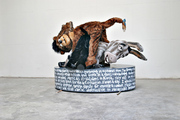 Verging on the sociological, exhibitions organized around national or ethnic identities often reduce complex issues of difference and affiliation to easily consumed, nonthreatening snapshots of foreign cultures. While “Your Bright Future” seems cast in this mold, it cleverly avoids that pitfall by addressing the tensions and contradictions that vex the concept of national identity in an increasingly transnational world. To begin with, eleven of the twelve artists either reside or were educated outside Korea, and many of the works explore a sense of transience and displacement. Haegue Yang’s installation of her artworks in shipping crates literally embodies this idea, while Do Ho Suh’s ghostly resin sculpture, Home Within Home, 2009, embeds a traditional Korean-style structure within a Victorian apartment building. Also with an eye on the domestic, Kim Beom fabricates trompe l’oeil household items out of food products, leaves them outside to disintegrate into the dirt, and records the process in a time-lapse video. By framing such disparate works as “Korean,” the show invites a broader interpretation of national identity that embraces not only the diaspora but a pervasive sense of mutability. At the same time, it smartly eschews borderless internationalism, offering pointed critiques of political and economic imperialism that bespeak Korea’s recent history as a divided, postcolonial country. For example, Gimhongsok’s life-size stuffed animals look like tired Pop art, until you read the accompanying texts about Mexican and North Korean migrants paid a pittance to stand motionless inside them. More subtle but no less affecting is Bahc Yiso’s Wide World Wide, 2003, a disorienting world map in which the land masses are formed by rows of Korean text overlaid with English labels. Yet instead of the usual cities, states, and countries, the map denotes only the names of obscure locales, quietly defying both the viewer’s expectations and the imperial powers that carved the world into nation-states in the first place. |
 The publication of Laura Mulvey’s seminal essay “Visual Pleasure and Narrative Cinema” launched innumerable theoretical discussions and artistic interrogations with its assertion that female characters in films of the 1950s and ’60s exist primarily for the scopophilic enjoyment of male viewers. In particular, Mary Ann Doane’s “Film and the Masquerade: Theorizing the Female Spectator” posited that the reaction of female viewers to such cultural artifacts is typically either masochistic or narcissistic due to the act of self-identification. Although it seems plausible that the ensuing scholarship has exhausted the gaze as a theoretical device, this exhibition offers a comprehensive exploration of its less considered use: the way it functions between women. Given the heavily misogynist overtones implicit to the gaze posited by such discourse, the images in this survey demonstrate transformation and subversion, and each contributes to an understanding not only of the female gaze as concept but additionally of major themes in art history and feminism from the past century. Julia Margaret Cameron’s vintage photograph May Prinsep (Head of St. John), 1866, for instance, might initially seem connected to Lisa Yuskavage’s Heart, 1996–97, only in that both depict women. The first image is a portrait of a young female relative of the artist whose direct gaze meets that of the viewer while her hair flows loosely in a gesture that would have been considered suggestive at the time. The latter offers a bright pink background and a curvaceous, nude woman facing the viewer while she masturbates on her knees. Together, the works evoke a sense of continuity in the evolution of cultural attitudes toward gender and sexuality in their portrayal of sensuality without objectification. Although Yuskavage’s painting doubtlessly lacks the subtlety of Cameron’s earlier picture, each piece eschews the male gaze through an implicit sense of empathy with women. |
 If the classic English garden is an artwork of landscape representing an idealized, pastoral nature, curator Francesco Manacorda’s exhibition in the heart of London promises to offer a landscape of artworks reflecting a nature that is every day less natural and more aberrant. The Barbican will present more than eighty works, in a variety of media, by twenty-five artists and architects—from Joseph Beuys, R. Buckminster Fuller, Hans Haacke, Robert Smithson, and the Ant Farm collective to a younger generation of practitioners, including EXYZT, Heather and Ivan Morison, R&Sie(n), Philippe Rahm, and Simon Starling. By extending the installation onto the surrounding grounds, Manacorda and co. will necessarily provoke thoughts about the radical (and threatening) artwork that nature itself has become. |
 Sarah Morris’s exploration of the elaborate conversation between architecture and power can be found most recently in her sequence of paintings and films concerned with the Olympic Games. In addition to this show’s substantial group of paintings, an extensive, site-specific wall work, and two other films from the past decade, the Museum für Moderne Kunst—in conjunction with Italy’s Museo d’Arte Moderna di Bologna, which is presenting a concurrent survey exhibition of the artist’s work—will co-premiere Morris’s feature-length film Beijing, 2008, documenting the city’s preparations for last year’s opening ceremony amid the numerous lavish architectural projects constructed for the games. In Frankfurt, Morris’s paintings, rich in their references to Pop, post-painterly, and Minimal art of the 1960s, will be contextualized with examples from these movements culled from the museum’s collection. |
 A London-born artist who resides in New York, Cecily Brown has described painting as “a kind of alchemy,” adding that she wants “to catch something in the act of becoming something else.” Steeped in art history, with avowed debts to Abstract Expressionism and the old masters, Brown’s output flaunts vigorous brushwork that both integrates and transforms images drawn from pornography, cartoons, Victorian storybooks, and the like. Filling the skylighted spaces of the Deichtorhallen with a survey of some fifty works on canvas and paper from the past ten years—with an emphasis on Brown’s large-scale paintings—curator Robert Fleck sets out to affirm Brown’s reputation as one of the most influential young painters working today. A catalogue—featuring essays by Fleck and art historian Dore Ashton, as well as an interview of Brown by Lari Pittman—accompanies the show. |
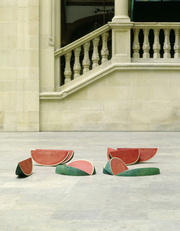 Using irony and subtle humor to challenge monumentality, Thomas Schütte’s work counters the “straightness” of modernity with gestures of stumbling and failing—a strategy that should prove key in taking on the bombastic architecture and difficult National Socialist past of Munich’s Haus der Kunst. Centered around an eighteen-foot-high Styrofoam and plaster “anti-monument”—here referencing Schütte’s “Mann im Matsch” (Man in Mud) series—this substantial survey brings together more than one hundred works made since the early 1980s, including sculptures, architectural models, watercolors, and ceramics. Curators Dander and Weski highlight Schütte’s reflections on “ambivalence, tension, and conflict” throughout this wide range of media, but the accompanying catalogue is dedicated solely to the artist’s newest watercolors. |
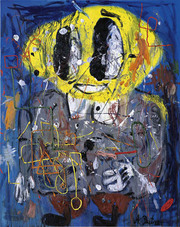 Since the late 1990s, German painter André Butzer has been tinkering away in his thick, expressionistic impasto to create an alternate universe populated by such curious figures as the death-faced Wanderers and ungainly augurs of good fortune, the Friedens-Siemense (named after the multinational corporation). Butzer, with disarming irony, describes his work as “science fiction expressionism”—locating the orbits of Asger Jorn and Albert Oehlen within waving distance. The Kunsthalle Nürnberg now opens its galleries to this radical (anti-)vision of the world with a concentrated selection of large-format paintings from the past decade. Judging from the show’s subtitle—“Many Die in the Homeland: Fanta, Sprite, UHT Milk, Mickey and Donald!”—Butzer’s own strain of dadaist absurdism will no doubt surface both visually and linguistically. |
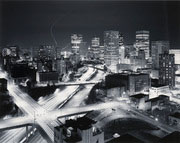 In a show that holds up the CCA’s usual intelligent standards, Stanford Italianist Jeffrey T. Schnapp presents his angle on the centenary of Futurism by examining the legacy of its most fervent dream. We can expect not only streamlining and hygienic bodies but also—among the show’s 240 works including videos, photographs, posters, and collages—ruminations on city and country, information architectures, “24 frames a second,” and chemical stimulants. Explicit in Schnapp’s framing of the exhibition—and in the multiauthored catalogue-cum-reader that accompanies the show—is a critical questioning of the beauty of speed, now vexed by the cost of progress: Our cultural Luddism increasingly poses slow food against fast, “mindfulness” against Benjaminian distraction, and reflection in place of “blink” decisions. |
|
| Statistics |
Total online: 1 Guests: 1 Users: 0 | |









